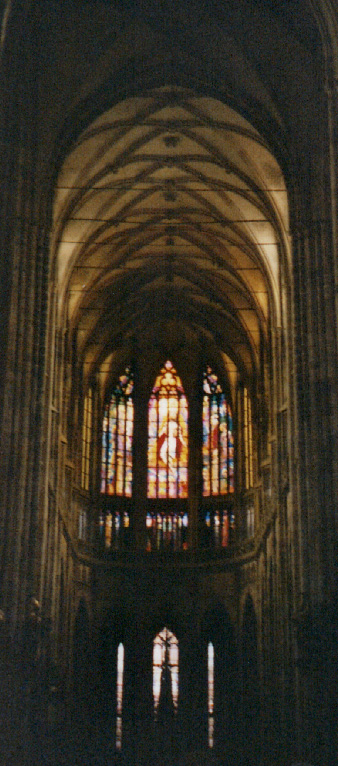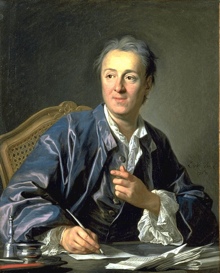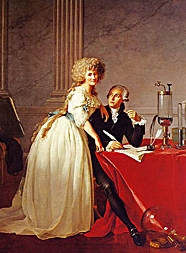The place of technology in creating the dimensions of our lives is embodied in architecture.
![]()
Background | surface features | interior or undercurrent structure | elaboration | Meaning
Chapel: a place of sanctuary and reflection;
an enclosure that is a feature of a larger Cathedral.

"timeless architectural rendering"
![]()
Surface features | interior or undercurrent structure | elaboration | Meaning
Invention takes place over time with the aid of
"thinking with the mind's eye."
| Context | label | source and meaning |
| So you can avoid false beliefs: | Pursell, pp 39-41. |
|
|
1. |
progress |
the inevitability of improvement. |
|
2. |
markets | the effective benevolence of the marketplace - markets. |
|
3. |
ingenuity | solitary and creative geniuses will in time prevail. |
"Thinking as picturing"
Through the production of the alphabet or language for technical invention through drawing and model building that allows us to comprehend the–
result "seeing" how parts go together.
Surface features | interior or undercurrent structure | elaboration | Meaning
Surface features are easier to see
Short-term
In one important sense the ideas of the 18th Century took older findings from many people and fused these into basic assumptions about the perfectibility of human life, the rationality of human potential, and the equality and independence of human thought, actions, and responsibility.
These ideas came from Galileo's assumptions through Thomas Hobbes geometrical rationalizing of human affairs, Descartes' beliefs in the necessity for doubt and mathematical comparisons, the conceptual frame of Kepler's and Newton's laws of motion applied to human relations, John Locke's psychology of sensations and civil order, Rousseau's beliefs in the virtues of the state of nature, and an underlying faith in progress as a facet of modern life due to inventions, discoveries, and new sources of power.
Two important people in this "intelligent" view of the human condition were:
| Codification of knowledge | Discovery of hidden |
 |

|
| Denis Diderot, author of the Encyclopedia | Antoine Lavoisier experimental natural philosopher |
Surface features | interior or undercurrent structure | elaboration | Meaning
Mechanization gives way to automation
Context of applying visualization to solving problems through inventive endeavors
1770, the steam engine, through a mistake
1780, the development, but not the deployment (dispersal) of steamboats.
1825, earliest steam locomotives to move freight and people, called trains today.
Humphrey Davey begins a series of public lectures to the working class on science.
1830, visualization of the unseen and seen: the popularization of science education
by Michael Farraday and Humphrey Davey using electricity and magnetism
and of geology of rock formations in diverse places by Sir Charles Lyell.
1832, the British Reform Act giving labor some rights
Samuel F. B. Morse "sketches" the concept for a telegraph system
1835, Railroads dominate transportation in Europe and America, Darwin returns to Kew from global voyage.
1859, On the Origin of Species by Charles R. Darwin, triumph of "a strong visual memory."
1870, Electricity is "conceptualized" as electro-magnetic induction
James Clerk Maxwell develops mathematical "field equations" revealing inverse relation of current to attraction.
Bell and Edison perfect the same tool: the telephone using visualization, sketches and models.
Underlying structure is difficult to detect
Long-term
A visual revolution in how we conceptualize, draw, & represent space:
1299, Florence bans the use of Arabic numerals
1300, Arab geometry and mathematics spreads in Europe from Baghdad
1400, The Chinese calculate the length of the solar year to 365.25 days
1440, Johann Gutenberg, in Mainz, develops "movable type" for printing
1450s, perspective drawing employed in the art of painting
Alberti publishes a book on the use of drawing with perspective in art
Brunelleschi employs perspective in measuring accurately and recording the dimensions of Roman ruins
1453, Turks sack & burn Constantinople -- the seat of western learning, craft and wealth. (29 May)
1492, Columbus sails to the Azores and Bahamas.
1500, Leonardo Da Vinci (notebooks of drawings) moves to France
1543, Copernicus "mechanical" model of the heavens & Vesalius Anatomy are published.
"inventions relating to pictorial perspective and drawing to scale assisted in the development of a new conceptualization of space."
p. 51.
"shift to the visual" at this time in many aspects of European culture, that it had the effect of striking the match" that set the scientific revolution ablaze.
"'visualization' was a major component in the new mode of scientific thought."
p. 53.
"A more general point about the significance of visualization for the scientific revolution is that the distinction between objective and subjective experience became a distinction between what could be seen and what could not."
"There is not only this ability to see better but also the possibility of conceptualizing many things differently."
Role of intuition in a chain of logical progression for solving problems:
"Here intuition refers to thinking of the kind described earlier in which ideas emerge from visual experience without intermediate stages of verbal reasoning--ideas that can then be discussed verbally or tested using mathematics or experiment."
"the predictability of the future does not follow" from ... "or are determined by identifiable causes....."
p. 55.
Cause and effect are newly redefined by new formulas of visualization
the new vision of fractal geometry based on chaos theory:
This "is a version of causality that gives rise to apparently spontaneous unpredictability"
p. 56.
Pacey concludes:
Once music alone could capture the fluid quality and "movement" of things in the world, but now due to a recent and a far more remote change in our capacity to visualize the world --"our mind's eye" (Pursell) can "see better" (Pacey) because
"Now, it seems, the computer has extended the range of visual expression into areas with which only music could previously cope."
Pacey, Meaning in Technology, p. 57.
Meaning:
"there is a shift to the visual in the Renaissance --from the merely literary-- causing an emergence of an entire "new world" of science corresponding to the geographical discovery of a new world by explorers who made the shift from mechanization to automation possible."
In the Church organ lies the seeds of automation that did not sprout until the ground of art and science shifted and converged in the Enlightenment with machinery. As machinery dominated 19th century social relations and working experience, automatic controls were necessary for the safe operation of "explosive" tools.
The development of electricity based on James Clerk Maxwell's precise mathematics was helped by a "visualization revolution" in explaining the world, a new language of mathematical symbols and the practice of crafts people who invented, perfected and sold control devices for steam engines in manufacture and transportation.
read Pacey, pp. 39-58.
Related topics:
 |
||
|---|---|---|
| Tools of Toil: what to read. | ||
| Tools are historical building blocks of technology. | ||